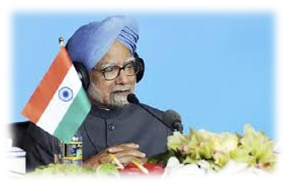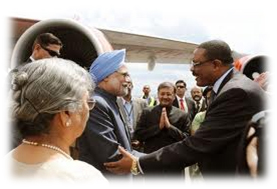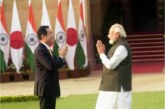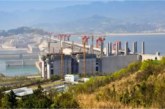By Dr Arvind Kumar
Africa, a continent largely neglected by the Western powers over the 1990s, has re-emerged as a key arena within which these new geographies are playing out.1 African markets, but more particularly resources – above all oil, but also minerals, ores, timber, fisheries and even land – have been re-evaluated by potential producers, traders and investors around the world, producing a set of economic logics that have complex consequences when interwoven with other areas of concern, including geopolitics, security and development.
Recent years have witnessed a surge of policy and commercial interest in what appear to be significant changing global geographies of investment, trade, aid, economic growth and geopolitical power. An array of new terms and acronyms has burst upon the scene – notably the ‘Asian Drivers’, the ‘BRICS’ (Brazil, Russia, India, China and South Africa), and the ‘Rising Powers’.2 Key issues include the implications and impacts of sustained high growth rates (although with new uncertainty accompanying the global financial crisis); growing energy competition; deepening trade deficits; and changing terrains of ‘soft’ and even, arguably, ‘hard’ power.3
New alliances are being formed, such as ‘IBSA’, a joint negotiating platform set up between India, Brazil and South Africa; while old ones, like the G77, are being re-invigorated. South–South regional associations, bilateral agreements and diplomatic ties are flourishing. Thus, once again it seems, the countries of the South are mounting a challenge to the existing uneven architectures of economic, political and institutional power. However, there still remain profound structural, ideological and political differences between poorer countries, however they are grouped.4
The roles and impacts of a number of ‘new’ players in Africa have been the subject of considerable attention, although this is understandably heavily tilted towards analyses of China. The reasons for this uneven attention are first and foremost China’s significantly larger scale of economic interactions with the continent. Rather overshadowed by all of the China-Africa analyses, have been recent interactions between different African countries and other non-western countries – including Brazil, Iran, Japan, Malaysia, Qatar, Russia, South Korea and Turkey.5
As regards India then, a number of analysts suggest that it may well achieve a more prosperous and stable economy in the longer term than China, while in the shorter term, its economic and political profile may result in a more productive relationship for many different African countries, sectors and constituencies. But India will also bring its own challenges, in its commercial interactions, its bilateral relations and through its part in shaping the multilateral polity and global economy.6
Historical Background
 India’s relations with Africa can be traced back to ancient times. Contacts and trade between the people of the eastern seaboard of Africa and the western seaboard of India have been going on for centuries. However, the relationship has swung from a period of great emotional and political solidarity in the 1950s and 1960s to selective engagement in the 1970s and 1980s. In the post-Cold War era in Africa there is a growing perception that it was marginalized, both politically and economically.
India’s relations with Africa can be traced back to ancient times. Contacts and trade between the people of the eastern seaboard of Africa and the western seaboard of India have been going on for centuries. However, the relationship has swung from a period of great emotional and political solidarity in the 1950s and 1960s to selective engagement in the 1970s and 1980s. In the post-Cold War era in Africa there is a growing perception that it was marginalized, both politically and economically.
Jawaharlal Nehru, India’s first Prime Minister laid the foundation for India’s Africa policy. The importance of Africa, he felt, arose from the fact that “though separated by the Indian Ocean from us, it is in a sense our next door neighbour.”7 There were two major strands of his policy towards Africa. The first was the support for the struggle against colonization and racial discrimination in South Africa. On these issues India was very active at the United Nations. The second was related to the people of Indian origin settled in Africa. He advised the Indians to identify themselves with the local community, adopt a more positive attitude towards the political aspirations of the people of their adopted countries. In economic matters, he advised them not to seek any special privileges at the cost of equal opportunities for the Africans.8
The Africans acknowledged both Nehru’s and Mahatma Gandhi’s support for the African struggle. Mazrui says that Gandhi’s message of non-violence and passive resistance inspired many black leaders in Africa including Kwame Nkrumah of Ghana, Kenneth Kaunda of Zambia and Julius Nyerere of Tanzania.9 Similarly, as the Cold War began, Nehru’s principle of non-alignment appealed to the Africans.10 However, towards the end of Nehru’s tenure, India’s Africa relation dipped to a low. Few African nations gave diplomatic support to India bilaterally or at multilateral fora like the Non-aligned Movement (NAM).11
The developments obtaining in the post-Cold War era have called upon both Indians and Africans to march together to the tune of geo-economics. Based on historic friendship, India and Africa can still be partners in the struggle against under-development, poverty and other common problems. Broadly speaking, India’s Africa policy in the post-Cold War era is based on five key factors:
- Promoting economic cooperation
- Engaging the PIOs
- Preventing and combating terrorism
- Preserving peace
- Assisting the African defence forces
Trade Relations
Recent trade trends reveal India’s growing synergy with Africa.12 Bilateral trade increased from $967 million in 1990–91 to $39 billion in 2008–09, while India’s exports to Africa grew from $394 million in 1990–91 to $14.6 billion in 2008–09. As a result, in 2008–09 Africa represented 8% of India’s total exports, up from 2.2% in 1990. Similarly, India’s imports from Africa rose from $573 million in 1990–91 to $24.3 billion in 2008–09, or 8.4% of India’s total imports, up from 2.4% in 1990–91. In 2008–09, South Africa remained the leading destination for India’s exports to Africa, accounting for 13.5%.
Petroleum products have become the largest items in India’s export basket in the recent years. Other important items include transport equipment, machinery and instruments, pharmaceuticals, non-basmati rice, manufactures of metals, cotton-yarn fabrics and made-ups, as well as primary and semi-finished iron and steel products. Crude petroleum accounted for a significant 58.6% of India’s total imports from Africa during 2008–09.
Other major items imported from Africa include gold, inorganic chemicals, metalliferrous ores and metal scrap, and cashew nuts.
India has taken several steps to enhance trade and investment in Africa, including the Focus Africa Program and the Techno-Economic Approach for Africa–India Movement (TEAM-9) initiatives. Launched in 2002, the Focus Africa Program initially focused on sub-Saharan Africa, with emphasis on seven major trading partners in the region: Ethiopia, Tanzania, Nigeria, South Africa, Mauritius, Kenya and Ghana. Together these countries account for 69% of India’s trade in sub-Saharan Africa. The program broadened in 2003 to add 17 other countries, including some from North Africa. The TEAM-9 initiative was launched in 2003 as a special co-operation model between eight West African countries and India.
At the same time, Indian chambers of industry, particularly the Confederation of Indian Industry, in partnership with the Indian government, Export–Import Bank of India (EXIM) and the African Development Bank initiated the India–Africa project partnership conclaves. Since 2005, four conclaves have taken place in New Delhi, along with mini-conclaves in Africa. The latest conclave was held in New Delhi in 2010. This conclave attracted 606 African delegates from 33 countries, and approximately 152 projects, to the total value of $10.5 billion were negotiated at the meeting.
In April 2008, at the first India–Africa Forum, Indian Prime Minister Manmohan Singh announced a number of initiatives that included a duty-free trade preference scheme for 34 African countries, as well as grants for projects in excess of $500 million over the next five to six years in the areas of railways, information technology (IT), telecommunications and power. India also offered to double the Lines of Credit (LOCs) extended to African nations from the current $2.15 billion to $5.4 billion over next five years. In addition, African students benefited from the forum, as India pledged to double the number of available scholarships.
India’s Investment in Africa
Recent years have seen massive increase in India’s outward foreign direct investment in Africa, from $556 million in 1997 to $18.43 billion in 2007–08. According to data from India’s Ministry of Finance, approved cumulative investments in Africa between April 1996 and December 2007 amounted to $5.7 billion.
Many Indian companies have invested in Africa in recent years, and India appears to view Africa as a possible source of raw material and energy sources to support its industrial growth. This is not surprising, as energy security is one of the major security challenges facing India today. Currently, India is the fifth largest consumer of energy in the world and is expected to become the third largest by 2020. India’s growing energy needs have pushed it towards energy co-operation with the African countries and, given the stagnant oil reserves in the country, Indian oil companies are actively looking to acquire overseas assets. Currently, around 18% of India’s crude oil imports are sourced from Africa (including the North African countries). Indian national oil companies, such as the Oil and Natural Gas Corporation Videsh Limited, have invested in equity assets in Sudan,
India is clearly seeking a robust, mutually beneficial partnership that will provide India with energy security and benefit Africa through ‘sharing our experience, capacity and technology in the energy sector … building local capacities and ensuring technology transfer.’13 During the 2009 India–Africa Hydrocarbons Conference, India identified five main areas of co-operation with African countries: buying more crude oil from Africa, investing more in upstream opportunities on bilateral basis, exploring opportunities to source more liquefied natural gas from Africa, making available India’s skills, talent and technology in cost-effective ways for the benefit of Africa and supporting community development programs in Africa so as to ensure inclusive growth.14
Indian investments are not confined to hydrocarbons alone, but found in a wide array of economic sectors, including agriculture. As the majority of African countries are looking for ways to enhance their food security by replicating the Indian ‘green revolution model’, further areas of collaboration could include providing agricultural inputs, agro-processing and watershed management. The Indian companies are also present in Africa’s secondary and tertiary industries. However, Indian corporates are not new to Africa and, in some cases, have been present in Africa for a very long time. For example, the Tata Group has been operating in Africa for more than six decades and is present in more than 11 African countries.15
India-Africa Forum Summit
The last week of May 2011 witnessed the convening of the second Africa-India Summit at Dar es Salaam, the capital of Ethiopia in which India’s Prime Minister Dr Manmohan Singh headed Indian delegation thereby setting the stage for a big diplomatic push into a continent that is of growing economic and strategic interest for India and Indian companies. In a statement released prior to his departure for Addis Ababa on 23 May , Dr. Singh said Africa is “emerging as a new growth pole of the world” and that India’s partnership with the continent based on the three pillars of capacity-building and skill transfer, trade and infrastructure development was a “living embodiment of South-South cooperation.”16 The Africa-India summit declaration, also called the Addis Ababa declaration issued here on 25 May 2011 at the end of the Second Africa-India Forum Summit, took note of a number of political issues, including piracy off the coast of Somalia, terrorism and U.N. reform. Specifically, the summit emphasized the need for countries to “exert utmost effort on U.N. Security Council reform during the current session of the U.N. General Assembly.”
In a separate document on a framework for enhanced cooperation between Africa and India, the two sides have envisaged a widening of the partnership to areas such as civil society and governance, science and technology, social development, health, culture, tourism, sports, infrastructure and media and communications. It was also decided that the next Africa-India summit would be held in New Delhi in 2014.17
India used the occasion of its second summit with Africa to announce a major scaling up of its financial commitment to the continent and also pledged to expand educational and training opportunities for African students at home and in Indian universities. Speaking at the plenary of the Africa-India Forum Summit on 23 May 2011, Prime Minister Manmohan Singh said India would offer $5 billion for the next three years under lines of credit to help Africa achieve its development goals. He also offered an additional $700 million for new institutions and training programs to be established in consultation with the African Union.
Indian officials later clarified that the $5 billion credit line represented an increase of $1.6 billion over the $3.4 billion that remains unspent from previous commitments but that an effort would be made to ensure the full amount is utilized by 2014. In his speech, Jean Ping, chair of the African Union Commission, said Africa had benefited enormously from the fact that India, Brazil, China and other rising economies had managed to keep the global economy growing at a time when the West was mired in crisis.18
Conclusion
The India-Africa relationship is not new; it draws on a long, shared history of struggle against European colonialism, and a determination to ensure equality in the post-colonial world order. Africa has played host to a large Indian diaspora, and independent India was among the first to take a firm stand against apartheid in South Africa. Following the first summit in 2008, India initiated several such efforts, including the Pan-African e-Network Project across 43 countries, which drew appreciation from the beneficiary countries.19
Both Africa and India need each other for their speedy economic development. African nations are endowed with natural resources which can be harnessed with India’s help for the benefit of both sides. Keeping this in view, India has proposed to set up many institutions to accelerate the process of development in Africa, with clear focus on infrastructure development and agriculture-related industries. They have the advantage of understanding each other’s requirements and aspirations because of their historical ties and close people-to-people contacts.20
That new proposals for capacity-building discussed at this summit cover fields as diverse as information technology, textiles, food processing, and weather forecasting underscores the needs of a continent seeking to stabilize itself economically and politically. As important, it highlights Africa’s recognition of rising India’s capabilities to assist other developing countries. It is best for New Delhi to use the present momentum to build its relationship with Africa in ways that will be of optimal benefit to both sides.
Notes
- For details see, R. Dowden, Africa: altered states, ordinary miracles, London: Portobello, 2009.
- G. Mohan and M. Power, “New African choices? The politics of Chinese engagement in Africa and the changing architecture of international development”, Review of African Political Economy, Vol. 35, No.1, 2008, pp. 23-42.
- See Joseph Nye, Soft Power: the means to success in world politics, Washington: Public Affairs press, 2005. Also see J. Kurlantzick, Charm Offensive: how China’s soft power is transforming the world, New Haven: Yale University Press, 2007.
- L.E. Armijo, “The BRICs countries (Brazil, Russia, India, China) as an analytical category: mirage or insight”, Asian Perspectives, Vol. 31, No. 4, 2007, pp. 7-42.
- R. Kapilnsky and M. Farooki, Africa’s cooperation with new and emerging development partners: Options for Africa’s Development, New York: United Nations, 2009.
- For more information see, S.K. Singh, India and West Africa: a burgeoning relationship, London: Chatham House Africa Program, Briefing paper, April 2007.
- Cited in T. G. Ramamurthi, “Foundations of India’s Africa Policy”, Africa Quarterly, Vol. 37, Nos. 1&2, 1997, p. 30.
- Ajay Kumar Dubey, Indo-African Relations in the Post-Nehru Era (1965-1985), Delhi: Kalinga Publications, 1990, p. 25.
- Ali A. Mazrui, Africa’s International Relations, Westview: Boulder, 1977, pp. 117-118.
- Ibid.
- Anirudha Gupta, “India and Africa South of Sahara”, in Bimal Prasad (ed.), India’s Foreign Policy, New Delhi: Vikas, 1979, p. 269.
- Trade figures here are compiled from statistics provided by India’s Directorate General of Commercial Intelligence and Statistics and Ministry of Commerce.
- Speech delivered by Anand Sharma, Minister of State, External Affairs on 23 June 2008 at the Institute of Defence Studies and Analyses (IDSA), New Delhi, See Anand Sharma, “India and Africa: Sharing a robust partnership”, in Ruchita Beri and U. Kumar Sinha (eds.), Africa and Energy Security, New Delhi: Academic Foundation, 2009, p. 23.
- Times of India, 6 December 2010.
- “Tata investment in Africa is worth billions”, available at http://www.thaindian.com/newsportal/world-news/tata-investment-in-africa-isworth-billions.htm .
- Siddharath Varadarajan, “In Manmohan’s visit, a new emphasis on Africa”, The Hindu, 23 May 2011.
- Siddharath Vardarajan, “India, Africa call for end to Libya bombing”, The Hindu, 26 May 2011.
- Siddharath Vardarajan, “ Manmohan ups African line of credit by $ 1.6 billion”, The Hindu, 25 May 2011.
- Editorial, “India in Africa”, The Hindu, 27 May 2011
- Editorial, “Indo-African ties: New focus will be economics”, The Tribune (Chandigarh), 25 May 2011.


